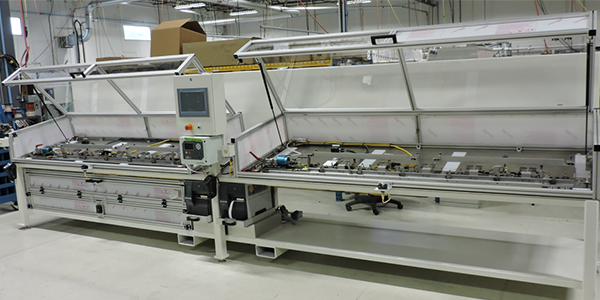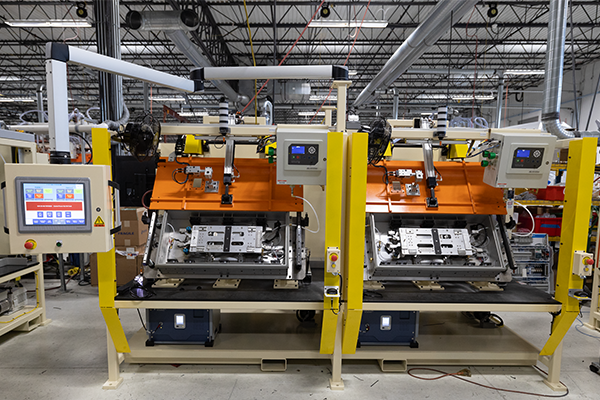How to Leak Test EV Battery Thermal Management Systems and Components
One of the unique challenges posed by electric vehicles is that the battery technology powering them generates substantial heat. Thermal management is essential for the safety and efficiency of the battery system as it is susceptible to overheating if not cooled properly. This makes a reliable, efficient thermal management system an essential element of the overall electric vehicle architecture.
Effective thermal management is crucial for the battery system, but it also impacts the safety and functionality of the temperature-sensitive power electronics that work in conjunction with the battery system.
Due to the large size of some of these components, like, for example, large cooling plates, and the expansion and temperature variation that can take place during test, leak testing processes for EV thermal management systems need to be carefully designed and balanced to ensure a safe and reliable vehicle.
Technologies Used for Leak Testing EV Battery Thermal Management Systems
Differential Pressure Decay
The most common method for leak testing EV Thermal Management Systems is pressure decay using a differential pressure measurement. A pressure decay test measures the drop in pressure on the interior of a part to identify a leak. Air is injected into the device until it reaches target pressure, then isolated and the loss of pressure (decay) is then measured over a period of time specified for the test.
Differential pressure decay leak testing is similar, but instead of testing the interior pressure drop, this method uses a differential pressure transducer to measure the pressure change between an external reference volume and the test part volume. Using differential pressure removes the thermal event that occurs from pressurizing a part to test pressure, thus providing a quicker test and higher level of sensitivity than the standard pressure decay method.
Pressure is typically tested in ranges around 20-50psig, dependent on the coolant circuit operating pressure, and 3-7 scc/m dependent on the leak path.
Trace Gas Accumulation
Trace gas accumulation can also be used for leak testing EV Thermal Management components. In a trace gas accumulation test, the part is filled with trace gas or helium and placed in a chamber. The chamber is at atmospheric pressure as the part is pressurized with a tracer gas. Over time, the tracer gas will accumulate in the chamber as a result of a leak being present in the part. Once the tracer gas has accumulated (typically at a rate of rise of 100 parts/million), a mass spectrometer measures the concentration change of the tracer gas in the chamber and a leak rate is calculated.
The trace gas accumulation method of testing reduces test variation from temperature issues that can occur, especially when testing large parts, and allows the manufacturer to achieve a highly repeatable, fast test cycle for high production environments.
Examples from the Plant Floor
CTS has helped leading manufacturers worldwide implement new EV testing solutions on their production lines. Solutions scale from simple test instrument integration at a retrofitted station, to full test machines designed from inception to delivery. Below are some examples of test machines CTS designed for EV manufacturers’ battery thermal management leak testing applications.
Battery Coolant Channel Assembly Leak Testing

This battery coolant channel assembly test stand was designed to accommodate testing two large coolant line assemblies. One Sentinel I28 is shared between two tests, with the manufacturer loading/unloading one station while the other station is in test. Parts are manually placed, manually locked, then pneumatically sealed using CTS Connect seals. The system then runs a differential pressure decay leak test, immediately flagging any failed, leaking parts for repair.
Battery Cooling Plates Leak Testing

This helium accumulation test machine was designed to leak test a battery cooling plate. The size of these electric vehicle batteries is quite large, which posed challenges in achieving a reliable, repeatable leak test. The helium accumulation method was selected as it provides a very quick measurement and very repeatable leak testing, safe from environmental disturbances or thermal events.
This test was designed using the CTS TracerMate II and an Inficon mass spectrometer. The battery cooling plates are placed into the test station, pneumatically sealed by CTS Connect, and the chamber lid is closed. The operator starts the test and the machine pulls vacuum on the part, backfilling it to test pressure with trace gas or helium. The air inside this chamber is mixed with fans and the rate of rise of trace gas outside of the part is then measured to determine if there is a leak.
Trust the EV Leak Testing Experts at CTS
CTS has been at the head of automotive leak testing for over 40 years, continuing to lead the way as production lines have evolved to produce electric vehicles. CTS has continued to innovate and apply its skills and technologies to the new needs of the industry. Our methods and technologies continue to be the most reliable and repeatable on the market. Contact the experts at CTS for your new EV line or improved performance on your current lines.
Looking for EV leak testing? Consult our experts


